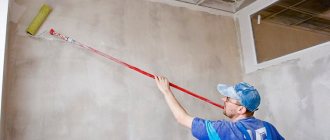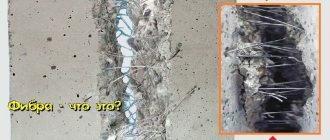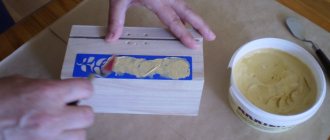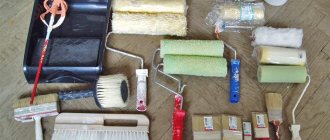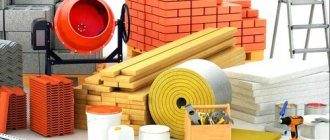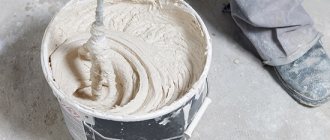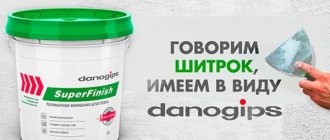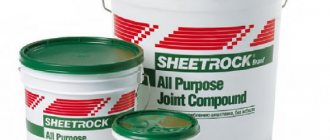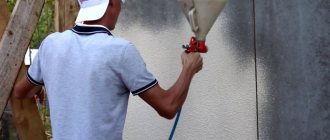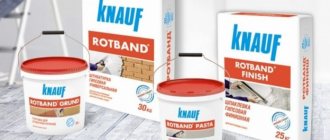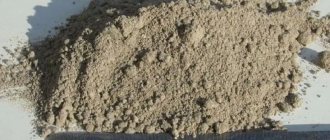Tex latex putty, popular among home craftsmenwho themselves carry out renovations of their apartments and country cottages, and from experienced professionals, involved in construction every day.
The material is designed to smooth out all existing unevenness after preliminary construction operations. The ready-made mixture eliminates defects on any type of surface: concrete, drywall, wood, brickwork. Here is about putty for wooden floors.
The unique innovative composition allows it to be successfully used as an excellent coating, which serves to create an even thin layer after all work has been carried out and the final finishing leveling of ceilings and walls.
Types of acrylic putty for interior and exterior work
Putty comes in several varieties depending on the scope of application:
- Facade putty for exterior use is distinguished by a specially developed composition that provides high strength and protective characteristics to the coating. The material is resistant to temperature changes, climatic precipitation, mechanical damage, has thermal insulation properties and insulates the room from the outside.
- Universal putty can be applied to different types of surfaces (walls, partitions, ceilings), various materials (brick, concrete, wood, metal, etc.).
- Water-dispersion putty has increased protection against moisture. The coating is durable, aesthetic, and resistant to temperature changes.
- Putty for interior work - the material is used for finishing rooms in an apartment or house. The composition is suitable for spaces with standard microclimate conditions without high levels of humidity and exposure to steam.
According to the form of release, putty is divided into the following types:
- Powdered - dry composition must be diluted with water before use. The variety is offered by manufacturers less often ready-made. The advantage of powdered material is the ability to independently select the required consistency. The composition can be saved, because the cost of production is lower than the mass diluted with water.
- Ready - offered in plastic buckets of 15-20 liters. The mass does not need to be mixed, the material is ready for application, easy to use, and optimal for beginners in the construction industry.
Separation of putty depending on the components:
- Starting - used for the initial stage of finishing work and involves the elimination of irregularities, depressions and cracks on surfaces.
- Finishing putty - the material is intended for final coating, because fixes the applied previous layers. The composition differs in decorative characteristics and is presented in different colors.
Compound
Latex putty Tex consists of a latex base. This is a binder, in addition to which the material includes:
- additives-modifiers;
- filling components;
- pure distilled water.
Many varieties of such mixtures have antiseptic substances in their structure. They protect the treated surfaces of walls and ceilings of a building from the appearance of damp areas, mold of fungal origin, and peeling of the coating from the application plane.
Polymer-bound building mixtures form a durable, elastic layer after drying. Treated surfaces are under serious protection from mechanical damage and penetrating humidity. The price of a standard package weighing 16 kg, offered by online stores, varies on average from 300 to 700 rubles.
Usage
Before the immediate start of repairs, the putty must be kept at room temperature for a certain period. The surface of finishing work should be treated in advance. It must be dry, cleaned, and free of fragments of the previous finish.
Surface cleaning
The next stage of work is preparing the mixture. The process of spreading latex putty is similar to preparing ordinary cement mortar.
Preparing the mixture
Putty and liquid should correspond to equal proportions (1:1). Next, the mixture should stand for approximately 2 minutes and then stir once, if necessary, add water.
Accordingly, latex mass, like other types, releases water quite rapidly, regardless of the primed surface. When suddenly faced with this kind of problem, when it is impossible to do a “stretch”, you need to resort to the following solution to the situation.
You need to soak the plaster a little with liquid and everything will return to normal. In addition, it is necessary to carry out such manipulation if the temperature is more than 30C.
Application
How long it takes for the putty to dry depends on the country of manufacture and labeling. The specified characteristics are indicated on the product label. Most often, drying time ranges from 2-6 hours, and consumption from 0.5-2.5 kg/m².
You can't use sandpaper all the time. You can accidentally “reset” the excess, or this grinding will bring a lot of difficulties. Therefore, to level, use a damp sponge if the putty has not dried completely. Check carefully to ensure that no excess liquid drips from the sponge.
Leveling with a sponge
Finishing putty - applying the final layer of substance to the surface.
Despite the thick layer, it will not burst, unlike the final one, which must be applied in a thin layer (1-2 mm) so as not to crack.
Full description – Latex façade putty for leveling building surfaces
Latex façade putty can be used not only indoors, but also for outdoor work. Corrects defects in wood surfaces, concrete and plaster. It can only be applied to metal surfaces after priming.
Before starting work, mix the putty; you can add water no more than 1% of the amount of putty. Surfaces are pre-cleaned and primed. You cannot work with this putty in frosty conditions.
It must be stored in a closed container, away from open flame. It belongs to environmentally friendly substances. Dries at room temperature for 4 hours.
Specifications
| Indicator name | Norm |
| Consistency corresponding to the immersion of a standard cone, cm | 6–8 |
| Drying time at a temperature of 20± 2° C, hour, no more | 4 |
| Sandability with 4–5 mm sandpaper | The dried layer of putty should be sanded and not stick to the sandpaper. |
Types and features of polymer putties
Polymer putty is a general definition that is used in relation to several types of compositions made on the basis of polymers. It is customary to distinguish three types of putty, which differ in the main polymer component:
- Polymer cement putty. The product is used as a leveling agent for cement-lime, cement-sand, brick and concrete surfaces. The plastic mass can be applied in a layer of up to 20 mm, which allows the use of polymer cement putty as a starting coating;
- Latex. The main component is styrene, it is also often called acrylic latex. Using the mixture, a neat and even finishing layer is obtained. The scope of application of the solution is very wide. The composition can be used on wood, brick, concrete or gypsum board. There are two forms of latex putty: dry and ready-made.
- Acrylic polymer. The main component is acrylic. The product is considered universal and can be divided into the following sub-items:
- Starting putty. Used to eliminate large flaws on the surface: cracks and potholes;
- Finishing putty. Completes the finish and gives the surface perfect smoothness. It is applied under wallpaper or paint composition;
- Universal putty. Includes the properties of the starting and finishing mixture.
Purpose
Tex Profi latex putty is recognized by experts as an indispensable material when carrying out interior finishing operations. Successful coating of all materials has long been used in the construction of real buildings.
With the same effect, the product is well applied to:
- wood fiber;
- plasterboard walls;
Application to plasterboard walls
- ceilings;
Ceiling application
- wooden surfaces;
Application on a wooden surface
- bricks;
Application to brick
- concrete.
Application to concrete
An exception to use may be metal surfaces. Putty containing latex is not suitable for them.
It is used for the purpose of leveling various non-metallic surfaces, which are subsequently prepared for painting with alkyd, oil, water-dispersion coloring compositions or for wallpapering.
Operations performed with latex putties:
- alignment of niches, corners , fines;
Aligning corners
- sealing cracks of complex configuration, depressions;
Sealing cracks
- texturing of surfaces of various nature: brick, plaster, concrete, wood. Here about wood putty;
- applying a thin layer to defects, potholes, and irregularities measuring 5-7 mm;
- finishing leveling , smoothing the planes of walls, ceilings, partitions. Here's about finishing putty for wallpaper.
Final alignment
For more information about latex putty, watch the video:
Technology
Preparing walls for applying Tex Profi putty
First you need to measure the amount of putty treatment. Considering the expected thickness of the putty, calculate the need. The sellers of the store where you bought it will tell you how to calculate the required consumption of putty per 1 m2 of substance.
Removing old wallpaper
Before applying putty, those surfaces that have been painted should be cleaned of previous whitewash or old paint. Sand surfaces with a glossy texture to a matte finish. Remove abrasive and dust by wiping with a damp cloth. Treat areas affected by fungus and mold with antiseptics.
Antiseptic treatment
Coat the cleaned surfaces with a water-dispersion primer.
When the primer has dried, you can begin to putty.
Primer
Plasterboard surfaces with joints and cracks are sealed with sickle tape. In this place about puttying drywall under wallpaper. It is glued on top to joints and cracks. The entire space around it is sealed so that the joint is not noticeable.
Necessary materials
Before you begin, you must purchase the following materials:
deep penetration primer. It is applied to the processing surface to strengthen and reduce moisture absorption. This will greatly facilitate all subsequent operations.
Deep penetration primer
serpyanka ribbon. This attribute is a must-purchase. When puttingtying walls under wallpaper from sheets for various purposes, it will not allow cracks to appear in the joints.
Serpyanka ribbon
Required Tools
To work you will need the following tools:
brush;
Brush
roller;
Roller
- the dishes are smaller than the bucket with purchased putty.
A latex substance in an open container releases moisture to the surrounding air, loses elasticity and its best consumer properties; - grater. This tool will need to grind the surfaces after processing;
Grater
one spatula 35 cm wide. It is needed for applying the putty mixture to the walls. The second spatula is 10 cm wide. It is needed for subsequent processing of hard-to-reach places;
Spatula
In order to align internal and external corners, an angle spatula is required.
Angle spatula
Application
When all the treated seams are dry, they are sanded and a primer is applied on top. Here's how long it takes for putty to dry. The puttying process is simple, since the substance is fully prepared by the manufacturer for use, is elastic, and easy to apply. Even a beginner can handle it.
It is not carried out using traditional sanding paper of various grain sizes. The operation is performed with a damp foam sponge. It washes away excess putty mixture
It is important not to allow the putty to dry completely, but to sand the slightly damp surface
Latex putty and its properties
Putty (or putty) is a building material used to smooth out irregularities and eliminate various defects on surfaces of any type (concrete and brick walls, wood, drywall, etc.). It is unlikely that anyone has been able to carry out repair or construction work without using putty.
Latex putty allows you to reduce the consumption of subsequent applied finishing layers
The modern building materials market offers a wide range of putty mixtures, which differ in their characteristics: composition, release form, features of use. On the shelves of specialized stores you can easily find cement, gypsum, acrylic, polymer putties, as well as latex, which has recently become increasingly popular among specialists in finishing work.
Like all others, latex putty consists of several components, but the binder in it is latex, known for its amazing elasticity. It is thanks to this component that the material has excellent qualities, such as:
- low shrinkage - you can be 100% sure that after drying no cracks will appear on the surface;
- high plasticity, which greatly facilitates finishing work and allows you to apply the thinnest layers;
- excellent adhesion - the putty adheres firmly to the surface of the walls and does not crumble after hardening;
- is produced in finished form, which saves time and does not involve additional tools and containers;
- sands well;
- has a long shelf life, provided that the container is hermetically sealed.
If we compare latex putty with other types to identify shortcomings, then we can name, perhaps, only two: a relatively high price and poor tolerance to low temperatures, which makes it impossible to use it in cold rooms.
Latex putty is produced in ready-made form, which increases its shelf life provided that the container is sealed
However, upon in-depth analysis, we can conclude that, despite the high cost, the latex analogue even helps to save money: its excellent qualities lead to less consumption of finishing materials when painting walls, and it also takes less time to work. And in order to avoid damage to building materials at low temperatures, containers with them should be stored in rooms where freezing is prevented, and work should be carried out at a temperature close to room temperature.
Manufacturers
The buyer needs to pay attention to the company that produces the product and read customer reviews about the quality of the product.
Companies offer latex mixtures that are resistant to aggressive influences:
- humidity;
- low temperatures;
- mechanical damage.
"Tex"
The manufacturer produces high quality products; putty for exterior use has an affordable price.
The buyer has the opportunity to purchase two types of latex coating:
- "Tex Pro";
- "Tex Universal".
The main advantages of the Tex Profi solution:
- applied in one layer;
- does not form cracks;
- subject to quick grinding;
- has been in use for a long time.
After drying, the putty forms a thin layer on the surface that protects it from damage.
Tex Profi mortar can be combined with other building compounds. The mixture can be stored for a long time if the container is closed with a lid; when compacting the composition, it is diluted with water.
"Tex Pro" has the following disadvantages:
- becomes unusable as a result of exposure to low temperatures;
- loses its performance properties after freezing;
- has a minimum shelf life;
- the goods are sold at a high price.
"Profilux"
Profilux latex mixture is packaged in containers weighing 1.5 kg and 1.6 kg. The consumption of polymer material is 4 m²/kg.
Water is used as a solvent. After applying the polymer composition, the surface acquires a matte tint. The putty is white and dries within 24 hours.
The finishing coating has the following advantages:
- strength;
- slight shrinkage;
- high degree of adhesion.
"Profilux" is used for exterior and interior decoration. The coating is produced by Meffert AG Farbwerke. The mixture weighs 16 kg and is packed in a plastic bucket. The shelf life is 1 year, the cost of 1 unit of goods is 614 rubles. "Profilux" has a quality certificate.
To treat wooden surfaces, use Profilux pine weighing 0.25 kg. The retail price of the product does not exceed 95 rubles.
Finishing solution is easy to apply, dries quickly and is the best option for finishing ceilings and walls. The putty is harmless to health and contains environmentally friendly ingredients. The polymer compound is used simultaneously with other decorative mixtures and paints and varnishes.
"Lakra"
The finished putty is packaged in a plastic container. The mixture is intended for interior work; the consumption of the finished coating is 3 kg/m². The polymer compound is frost-resistant and has a high degree of adhesion.
“Lakra” is used for final leveling of the surface of walls or ceilings in a room. It is applied to concrete surfaces to eliminate gaps between gypsum board panels. The mixture is used for work related to interior painting of the premises. The finishing solution is white, material consumption is 0.5-1.4 kg/1 m².
Lakra polymer coating is produced in Russia. The finished composition has a uniform consistency and is quickly distributed over the working surface. To obtain a thin layer, it is necessary to dilute the latex coating with water, using the included instructions.
During work, the master must take precautions, as the mixture is explosive.
"Optimist"
The putty is used for interior work. The product is produced in Perm, Rostov region and Moscow.
The mixture contains the following ingredients:
- acrylic latex;
- filler;
- thickener;
- additives.
The polymer compound is white, plastic, after the outer layer dries, the surface becomes snow-white. When working with Optimist putty, you must follow the main rule: apply it with a thickness of no more than 3 mm, otherwise the coating will deform or crack. The solution dries within 24 hours.
The finishing price depends on the weight of the product. Putty, packaged in a plastic bucket with a capacity of 5 liters, costs 360 rubles.
The polymer mixture "Optimist 1601" for interior work is produced in plastic containers with a capacity of 9 kg, 5 kg, 18 kg. The material is applied not only to wood and plaster. The mixture is used to cover chipboard, hardboard, and gypsum board panels. The coating consumption to form a layer of 1 mm is 0.8-1 kg/m².
In summer, the putty is stored in a closed container at a temperature of +5...+30°C. In winter, the material can withstand 5 cycles of freezing and thawing. The shelf life of the Optimist polymer mixture is 1 year.
"Hermes"
Latex plaster is used to cover walls, gypsum board panels, and ceilings in residential and basement areas. The solution consumption is 700 g/m². The putty is stored in a tightly closed plastic container for 1 year. The average price of a product is 431 rubles. per package weighing 15 kg.
Before starting work, the technician thoroughly cleans the wall of oil stains or loose deposits. The putty is applied in a layer of 0.5-1.7 mm and dried for 12 hours. Then the surface is treated with a reinforcing primer, mesh or reinforcing fabric.
The advantages of latex composition are durability and quick drying.
Kinds
Most common building materials manufacturers have seen widespread adoption and increased demand for their products. Which one is better? Each company decided to take advantage of this popularity and create their own latex putty production company.
Today there are a significant number of companies manufacturing building materials, and this complicates the choice of material.
Tex
Specialists in the field of repair activities are satisfied with this type, in cases where they are not buying fakes.
Tex
It does not burst, lays down very delicately, and sanding the surface of products is not particularly difficult. The surface is just as smooth and uniform.
Vetonit
According to the characteristics, it has an average indicator. But it’s easy to use, easy to dilute, and quick drying will only be a plus.
Vetonit
But when you start pasting the trellises, difficulties may then arise, since you will be able to remove the old wallpaper together with the putty. Often, in addition, it is capable of getting wet and pieces, along with the wallpaper, falling off the wall.
Knauf
More suitable for repair experts. Due to the fact that sanding is more difficult, it should be applied very carefully in order to make fewer mistakes.
Knauf
The highest quality putty is a composition from the German manufacturer “Knauf”. It is used by leading specialists in the field of renovation and design. It must be applied very carefully, for this reason it is not recommended for beginners.
Shitrock
It is soft to use, does not curl, and sands well. You just need to buy from a manufacturer of a foreign manufacturer (for example, the USA) - others were not suitable in quality.
Shitrock
In addition, it is possible to highlight the Sheetrock brand. If you have decided to buy putty from this manufacturer, then you need to highlight the fact that there are currently many fake putty consistencies from this manufacturer.
Caparol
Fits perfectly on walls, so they appear perfectly straight and smooth. Relatively inexpensive in terms of cost and consumption with other options. For people who have decided to start repairs for the first time, it is better to buy Caparol latex putty.
Caparol
You only need to directly purchase building materials in branded shopping centers, or you can choose putty directly from the manufacturer’s factory.
On wood
- common color palette;
- easy to apply and easy to sand;
On wood
- slight thermal shrinkage after drying;
- excellent adhesion.
Latex wood putty “Colorika Aqua” is an environmentally friendly product, odorless:
- ready-to-use products;
- will not require one or another high-quality training;
- has optimal adhesion;
- dries quickly;
Colorika Aqua
- easy to apply, including vertical materials;
- has slight shrinkage after drying;
- produced in different colors.
Wood putty “Colorika Aqua” is specialized in processing holes, sealing cracks, as well as correcting defects in wood products, intended to prepare the surface for further painting.
The composition includes acrylic copolymers, fillers, additional additives and chemically prepared liquid.
Review of the best brands
Choosing a suitable mixture is now quite difficult, due to the fact that the market offers a whole variety of putty materials.
Popular brands include:
- Sheetrock. Good material, applies evenly to the surface, easy to sand. However, when purchasing it, you should beware of fakes.
- Vetonit. The putty is soft and can be sanded well, however, it is vulnerable to a humid environment. In terms of its qualities, it occupies an average place.
- Knauf. Working with this putty is much more difficult. This type is more suitable for craftsmen.
- Caparol. One of the best materials for beginners. It applies evenly to the surface and does not leave cracks.
- Teks. Tex latex putty is another excellent option for both beginners in the construction industry and professionals. The putty lays on the surface in a thin layer, does not burst, is easy to sand and dries quickly. This is the optimal choice according to the price-quality formula. When purchasing, you should beware of fakes.
https://youtube.com/watch?v=CfCS8aybdqc
Advantages and disadvantages
With the support of such a composition, you will get a fairly flexible putty layer on the desired surface that dries uniformly. Thus, the material has the smallest volume and linear dimensions of the casting during their formation, as well as cooling from the casting temperature to the ambient temperature.
Due to these features, cracks and bubbles will not appear, and the putty will not crumble.
Key benefits:
- comfortable to use, flexible due to latex;
- very easy to apply, in the thinnest layers;
- adheres well;
- no shrinkage, which prevents cracks from appearing;
- after complete drying they do not crack.
It has two minor drawbacks that can be easily overcome:
price. Compared to other types, the price of latex putty is quite high. But you will reimburse these expenses with the result of the repair work performed and the speed of activity;
low temperatures – rather weak reaction to temperature changes
If during operation you notice that the product does not meet the listed requirements, the mixture may have frozen; Buy it preferably in stores with a guarantee of product return or exchange for a fresh product.
Please note that the product is completely covered with a lid and there are no traces of dried particles on it. Because after the completed manipulations, scratches appear during work, which again need to be puttied
Precautionary measures
- Latex putty is not toxic, but you still should not allow it to come into prolonged contact with unprotected skin. No one is immune from individual intolerance. If an allergic reaction occurs, the affected area should be immediately rinsed thoroughly with plenty of water.
- Do not forget to regularly ventilate the room in which work is carried out. Fumes released by drying putty can cause respiratory irritation.
- Unused putty remaining after repair work is strictly prohibited from being poured into sewers or natural reservoirs.
Characteristics
Latex putty Tex Profi 16 kg has the following characteristics:
- the thickness of the coating applied to the surface is from 0.5 to 3.0 mm. There is no longer a similar substance that could create such a miniature film;
- The amount of coverage directly affects the volume consumed. Here is the consumption of finishing material per 1 m2. It ranges from 0.5 to 2 kg/m². • Drying period of the substance is 24 hours;
- Warranty period of safety in warehouse: 1 – 2 years;
- the manufacturer's recommended storage conditions are to prevent freezing and defrosting, and to have special closed containers;
- the recommended temperature regime at the treatment site should not be lower than +5ºС;
- material packaging: plastic buckets with a capacity of 1-30 kg;
- chemical characteristics: Tex latex putty class Pro 16 kg does not contain toxic substances.
The characteristics of the substance from different manufacturers may vary slightly. Although latex putties do not contain toxic impurities and are environmentally friendly, when they get into human mucous membranes, they cause severe allergies. Any substance that comes into contact with the body must be thoroughly treated under a strong stream of water.
Advantages
The substance is easily applied, adhering well to the surfaces being treated. For home craftsmen and beginners in construction and repair work, it is best to work with similar compositions. They are elastic and do not leave pellets after pulling the spatula across the surface.
Reviews from experienced builders and plasterers about their quality are invariably positive. The putty can be applied in an ultra-thin coating of less than a millimeter in size.
The variety of colors provides a unique opportunity for users to save on varnishes and paints. Minimal shrinkage of the applied layer. Thanks to this quality, there are no bubbles, unevenness, height differences, or cracks on the surface treated with the substance.
Creation of a protective film on the surface of the applied layer. It reliably protects the coating, preventing it from drying out and cracking.
Flaws
Latex putty Tex negatively tolerates long-term exposure to sub-zero temperatures. Dry, ready-to-use mixtures and powders are often packaged by manufacturers in bags.
They are transported for days over long distances in frozen carriages and stored in drafty warehouses without heating. Our putty categorically does not accept such treatment. Freezing followed by defrosting causes its structure to become unusable.
When purchasing a product, you must carefully check the date of manufacture. If the substance was stored somewhere in winter, you should find out the storage conditions.
This is fully compensated by the high consumer quality of use, when there is no need to mix the necessary ingredients of the mixture. All this work was professionally done by the manufacturer. Numerous reviews on the websites of manufacturers and sellers of this type of putty are proof of this.
Despite the advantages and disadvantages, the material is gaining increasing popularity. Having recently appeared on the construction markets, the mixture confidently occupies a high place in the ranking of finishing materials among both home craftsmen and professional builders.
Characteristics
Latex putty is quite in demand among specialists due to its positive technological data. There is a huge range of different colors on sale to suit every taste. Latex putties have an advantage over acrylic putties.
Acrylic
Obtaining a latex composition of the required tone eliminates unnecessary costs for purchasing specialized dyes. Working with ready-made compounds is quite comfortable due to their flexible consistency.
Also, latex putties have significant adhesion and work according to the principle of thin rubber, perfectly leveling any surfaces and adhering closely to them.
When latex putty hardens, a non-cracking or crumbling shell is formed, which has an advantage compared to the use of acrylic.
The disadvantage of latex-based compositions, as already mentioned, is the inflated price and intolerance to low temperatures. Used for leveling planes made of various materials.
Latex putty has the following general characteristics:
- cover layer: from 0.5 to 3 millimeters;
- consumption: due to cover thickness from 0.5 to 2 kg/sq.m;
- Absolute drying period: 24 minutes;
- drying period between layers: 12 hours;
- savings period: 1-2 years;
- preservation requirement: in the original closed container, not allowing to freeze;
- conditions: at atmospheric temperature from +5;
- packaging: plastic container from 1 to 30 kilograms;
- non-toxic.
For more information about latex putty, watch the video:
How to choose a paint material
When it comes to choosing latex paint, you need to take into account 3 main requirements based on characteristics:
- Moisture resistant.
- Wear resistance.
- Durability.
However, gloss reveals all the imperfections and unevenness of the surface. Therefore, it is better to go with the semi-gloss version. It is recommended to check with the seller how many abrasion cycles the paint will withstand, dry and wet. The can usually says wet rub.
Latex paint for a ceiling in a dry room can have 1 thousand abrasion cycles, and for walls in a dry room - from 1 to 2 thousand. As for latex paint for a wet room, it is recommended to use compositions up to 3 thousand cycles. And for facade work – more than 10 thousand cycles.
The last important point is the class of paint and varnish material. It indicates the degree of abrasion. There are these types:
- The most stable is class 1.
- Cannot be washed with wet cleaning - class 2.
- It has a low level of abrasion, but is not afraid of moisture - class 3.
- Used for dry premises - class 4.
- The lowest indicator of resistance to dry and wet abrasion is class 5.
Below is a list of the best latex paint manufacturers:
Tips and recommendations for use
When working with polymer putty, professionals recommend adhering to the following recommendations:
- Apply the composition only to a previously prepared surface, cleaned of old coating, grease, dust and other contaminants. Before using polymer putty, the working surface should be treated with mineral primer.
- To mix the solution, the dry powder must be poured into a container with liquid and the contents must be thoroughly mixed by hand or with an electric drill equipped with a mixer attachment. Afterwards, the mixture should be left for 10 minutes and mixed again.
- The material is applied to the wall surface using a spatula or glue, in a layer no thicker than 0.3 cm. In this case, the algorithm of actions should be as follows. Using a trowel, a certain amount of the composition is collected, which is transferred to a spatula. Next, the tool with the prepared solution is applied to the working surface at an acute angle. The mass is not distributed in a dense layer over the base.
- When the putty mixture has dried, its surface is smoothed using sandpaper. To do this, make movements in a circle without excessive pressure. If one layer of the mixture is not enough, a second one can be applied no earlier than 4 hours after the previous one has dried.

